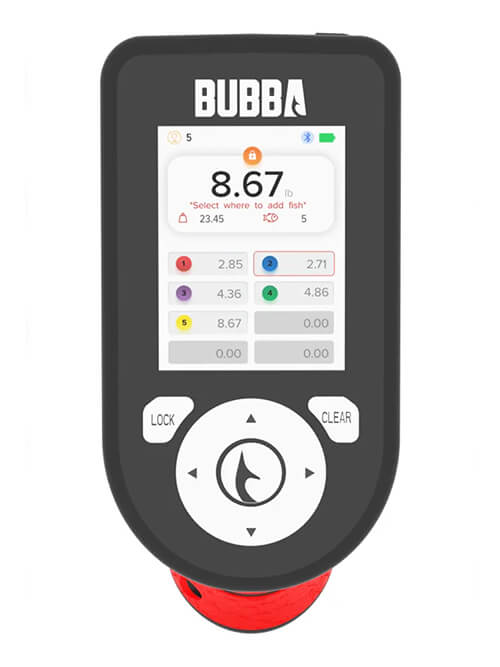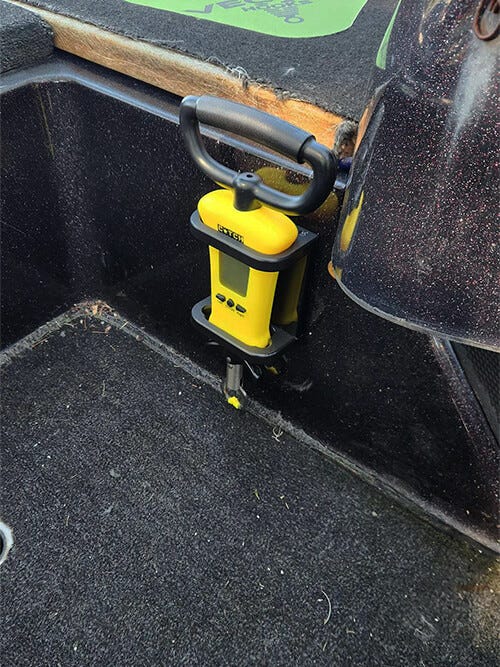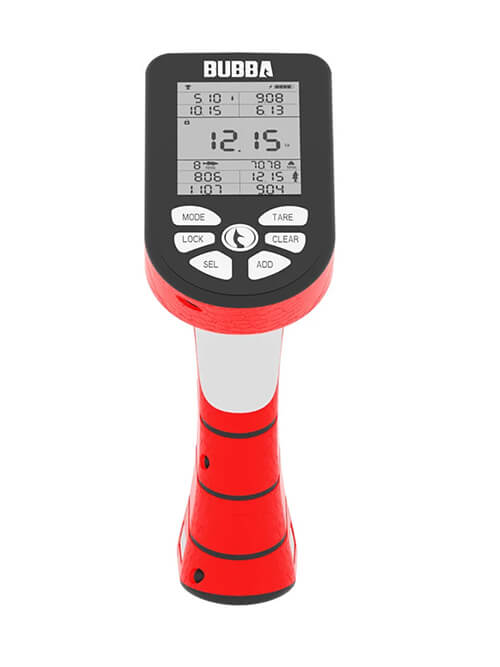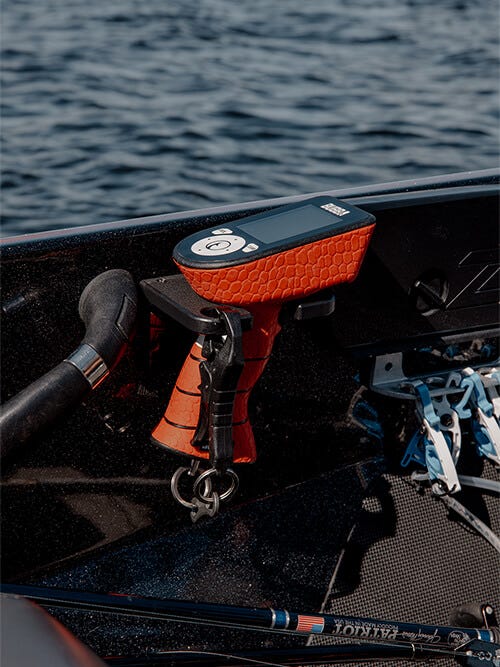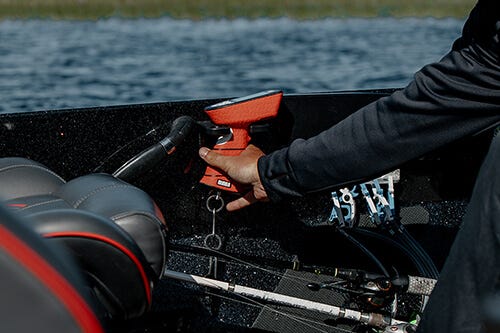

Remember that old spring-loaded scale with the built-in tape measure that slid around in the bottom of your dad’s or grandpa’s tackle box slowly accumulating rust? It has about as much in common with the newest generation of fishing scales as horse hair line does with eight-strand Spectra. Even relatively simple, inexpensive scales now feature easy-to-read digital displays, while top-of-the-line scales offer powerful and innovative capabilities far beyond what you might think a scale can do. Here’s what you need to know about these advanced weighing tools.
Contents
Culling Scales and Smart Scales
The multi-function scales we’ll be looking at in this article are commonly known as smart scales, culling scales or tournament scales.
There’s also a lot to discuss regarding single-function scales — which simply display the weight of a given fish — but tournament scales are different animals with far more complicated functions.
Even the simplest models are capable of storing the weights of multiple fish caught throughout a day and keeping a running total of their combined weight.
How Tournament Anglers Use Scales
In order to understand how culling scales came about, it helps to understand how bass and other tournament anglers use scales. If you’re a tournament angler yourself who is already familiar with culling, skip ahead!
With the exception of saltwater big game tournaments, most fishing tournaments — including bass, walleye and redfish — are scored on the combined weight of a “bag” of fish, which are almost always kept alive during the tournament and then released after weighing. The maximum number of fish in the bag varies. Most bass tournaments use a five-fish bag, but the number can be either larger or smaller. Tournament bag limits never exceed bag limits set forth in local fishing regulations.
If you’re fishing in a five-fish tournament — for example — and you catch five qualifying fish or less, you’ll bring them all to weigh-in. But if you’ve already got five fish in your livewell and catch a sixth, it’s time to “cull.”
That means checking to see if the sixth fish is heavier than any of the five already in your livewell and, if so, swapping out the smaller fish and replacing it with the new, larger fish. If fishing is good, this process might happen many times over the course of a day.
If you’ve never tried to identify and grab the smallest of five unhappy largemouth bass in a dark livewell, just know it’s not easy.
Now, if you’ve never tried to identify and grab the smallest of five unhappy largemouth bass in a dark livewell, just know it’s not easy. It’s not good for the fish, either, since it involves lots of contact. The solution is using “cull tags.” These are basically small numbered floats that clip harmlessly to the lower lip of each fish in the livewell, allowing you to tell one fish from another without removing them from the well. You might, for instance, put cull tag # 1 on your smallest fish, so you can easily lift it from the well to compare to fish you catch later in the day.
Smart Scales and Livewell Management
It might seem pretty simple to just swap out your smallest fish every time you catch a larger one once your bag is filled. But it’s not. That’s because which fish is your smallest changes all the time. So tournament anglers keep close track of every fish in the keep. This is typically referred to as livewell management. Every time a fish comes in the boat, it’s weighed carefully. If it’s going to be kept, the angler tags it and notes the color of the tag and the weight of the fish.
In the “old days,” anglers recorded fish weights and cull tag colors with a pencil and paper or a small whiteboard and a marker.
Later, the process of keeping track of exactly what’s in your livewell moved largely to smartphones, with a variety of apps designed specifically for culling.
But that still required two separate functions — weighing the fish with a scale, and then recording the information in an app.
Weighing fish and keeping track of weights no longer requires separate devices; both are accomplished with a smart scale.
In the simplest sense, smart scales bring those two functions together in a single device. Weighing fish and keeping track of weights no longer requires separate devices; both are accomplished with a smart scale. This not only simplifies livewell management but also reduces the chances for errors and equipment failure.
What Do Smart Scales Do?
Smart scales are a relatively new idea, and there are only a few models that are widely available to anglers. These include the Rapala Touch Screen Digital Scale, the Catch Commander and two different models from Bubba — the Bubba Smart Fish Scale and the Bubba Pro Series SFS. All of them offer the same basic functions: they weigh fish, save multiple weights, keep track of which cull tag is on which fish, and calculate combined weight. But some add additional functionality.
How Are Tournament Smart Scales Different?
Which smart scale is the best choice for you depends on a variety of factors, including budget. Smart scales range in price from about $50 to $200. Other factors include how you’ll primarily use the scale, what kind of fish you’ll use it to weigh, and where and how you’ll store it. Let’s look at some of the characteristics that differentiate one from another:
User Interface
Smart scales use different kinds of user interfaces, including touch screen, raised tactile keys and flush keys. Interfaces also vary in complexity, ranging from three physical keys to many touch-screen functions.
With the exception of the Bubba Pro model, which features a color LCD screen, all use a monochrome “alarm clock” style digital display.
Smart scales use different kinds of user interfaces, including touch screen, raised tactile keys and flush keys.
Battery Type
Most smart scales use disposable alkaline AA or AAA batteries. Bubba models can also use a rechargeable lithium battery which comes with the Pro model and is available as an add-on for the regular model.
Cull Limit Options
The cull limit is the maximum number of fish allowed to be weighed in a tournament. Although five is the most common number for bass, limits do vary. Different scales have different maximum limits. If a fish is weighed after the cull limit is reached, the scale alerts the user that a fish has to be culled. All allow the user to set the limit except the Rapala scale.
Weight Range
Scales also vary in the maximum single-fish weight they can measure, from 15 lbs. per fish to 60 lbs. For most tournament fishing, 15 lbs. is plenty. If you catch a bass or walleye over 15 lbs. in a tournament, there’s a 100% chance you’re weighing it in. And while redfish anglers often catch fish in excess of 15 lbs, state slot limits don’t allow keeping fish that large. On the other hand, if you’ll use the scale when fishing outside tournaments, the higher weight capacity can be helpful.
For most tournament fishing, 15 lbs. is plenty. If you catch a bass or walleye over 15 lbs. in a tournament, there’s a 100% chance you’re weighing it in.
Startup Time
How long it takes between pushing the “on” button and weighing a fish is an important consideration in tournaments. Most scale manufacturers don’t publish startup times, but Bubba boasts a very fast three-second startup.
Lock Mode
Weighing a flopping fish with a handheld scale on a rocking boat is delicate work as the displayed weight fluctuates constantly. With some scales, the angler automatically “locks” the weight at a certain figure. With others, the scale selects what it thinks is the best weight and locks it in. And with others, the user has a choice between manual and auto lock.
Form Factor
Scales vary in size, shape and weight. This matters not just for storage but also for ergonomics. “Pistol grip” type scales tend to be more comfortable to use than traditional scales with a top handle.
On the other hand, the more traditional form factor is less bulky in a compartment.
Water Resistance
A common complaint with digital fish scales is that they aren’t waterproof, which means they tend not to last long on a boat. All of the culling scales discussed here are at least water resistant, but some are more so than others.
Tournament Culling Scales: Bubba, Rapala, Catch Commander
There are really only a few choices on the market when it comes to culling scales. Here’s a quick summary of the strengths, weaknesses and peculiarities of each in order to help you choose the one that’s right for you.
Catch Commander
The Catch Commander is the “OG” of tournament culling scales, invented in 2018 and widely used by tournament bass anglers of all levels since then. It’s in the middle of the road pricewise, roughly equivalent to the non-Pro Bubba scale.
The Catch Commander is the “OG” of tournament culling scales, invented in 2018 and widely used by tournament bass anglers.
User interface — Monochrome screen with two raised control buttons plus a power button.
Batteries — Two AAA alkaline. Battery life not published. Users report long life.
Cull limit — User selectable from 1 to 10. Five weights viewable on screen at one time.
Weight capacity — Up to 30 lbs.
Startup time — Not published.
Lock mode — Automatic, but with a workaround.
Form factor — Conventional scale shape with top handle.
Water resistance — Advertised as waterproof but no spec listed.
Features and Notes — The Catch Commander scale lacks some of the bells and whistles of the Bubba models but is a proven, solid tool known for reliability and a straightforward interface. The more conventional form factor and removable handle make it easier to store than pistol grip style scales.
Rapala 15/50 Lb. Touch Screen Scale
Rapala offers two different versions of essentially the same scale: the Tournament Model, with a weight limit of 15 lbs. and a cull tag set included, and the Angler Model, which works the same but has a 50-lb. weight limit and doesn’t include cull tags. Both models are less expensive than Catch Commander or Bubba scales.
Rapala’s culling scales are the least expensive of the bunch and feature a nice touchscreen interface that’s simple to use.
User interface — Monochrome touchscreen with physical power button.
Batteries — Two AA alkaline. Battery life listed as up to 400 hours.
Cull limit — Fixed at 8, although users can manually replace fish in the first 5 caught. Eight weights shown on screen.
Weight capacity — Up to 15 lbs. or 50 lbs, depending on model.
Startup time — Not published.
Lock mode — Manual only.
Form factor — Pistol grip style.
Water resistance — Advertised as “water-resistant.”
Features and Notes — Rapala’s culling scales are the least expensive of the bunch and feature a nice touchscreen interface that’s simple to use. They do, though, lack some features that are important to tournament anglers, like the ability to set a cull limit and the option to let the scale automatically lock in a weight.
Bubba Smart Fish Scale
Bubba is the new kid on the tournament scale block but also the most popular at the moment. Both of the company’s models were released in spring 2023. The Non-Pro version scale is similar in price to the Catch Commander and offers similar functionality but with an updated interface and different form factor.
The Bubba scale’s six dedicated function keys take a bit longer to learn but allow for fewer pushes once you do.
User interface — Monochrome display with six flush buttons plus a power button.
Batteries — Two AA alkaline or optional rechargeable lithium ($20). Battery life not published but company says rechargeable battery lasts longer.
Cull limit — User selectable from 2 to 8. Eight weight shown on screen.
Weight capacity — Up to 60 lbs.
Startup time — 3 seconds.
Lock mode — User selectable.
Form factor — Pistol grip style.
Water resistance — IPX7 (can be immersed in 1 meter of water for 30 minutes without damage).
Features and Notes — Bubba’s Smart Fish Scale does basically what the Catch Commander does but with more style and a slicker interface. Its six dedicated function keys — compared to just two directional keys on the Catch Commander — take a bit longer to learn but allow for fewer pushes once you do. The Bubba also adds a second “mode” called Rally Mode. Instead of culling, Rally Mode keeps track of the total number of fish caught (up to 99) and the total weight, displaying the 7 heaviest and the lightest. The 60-lb. weight capacity makes it saltwater-ready.
Bubba Pro Series Smart Fish Scale
Bubba’s Pro Series scale costs about twice as much as the non-Pro version but adds a color display, a rechargeable lithium battery pack, and all kinds of innovative functionality.
Whether the added bells and whistles are worth the higher price tag depends on how you fish.
The Bubba Pro Series scale does everything the non-Pro version does but adds a color display, a third mode and wireless connectivity.
User interface — Color display with menu-driven interface, featuring a directional keypad plus two dedicated function buttons and a power button.
Batteries — Rechargeable lithium ($20). Battery life approximately 8 hours with unit continuously turned on and screen at full brightness. AA alkaline batteries can also be used.
Cull limit — User selectable from 2 to 8. Eight weights shown on screen.
Weight capacity — Up to 60 lbs.
Startup time — 3 seconds.
Lock mode — User selectable.
Form factor — Pistol grip style.
Water resistance — IPX7 (can be immersed in 1 meter of water for 30 minutes without damage).
Features and Notes — The Bubba Pro Series scale does everything the non-Pro version does but adds a color display, a third mode and wireless connectivity. The third mode, Competition, is designed to allow up to four anglers to compete informally against each other using a single smart scale. Anglers enter their catches, and the scale keeps track of total bag weights and fish counts.
The Pro Series Scale comes with a two-year subscription to Bubba’s mobile app, which allows you to connect the scale to your smartphone and control it from the app, log the location and local weather conditions for every fish you weigh, and even run live “virtual tournaments” with other anglers using the app and a Bubba scale.
Smart Scale Storage
Even though all tournament culling scales are at least water resistant, they’re relatively fragile, precision instruments that you don’t want to toss on the deck or in the bottom of a tackle locker.
The Bubba Pro Series even comes with a floating IPX7 carrying case that looks like something you’d store a microscope in. As much as scales need to be handled with care, though, they also need to be readily accessible in order to weigh and cull fish as quickly and efficiently as possible.
As much as scales need to be handled with care, they also need to be readily accessible when on the water.
One solution to the challenge of keeping your smart scale safe and out of the way but also ready for action is Boat Outfitters’ line of smart scale holders. These holders are machined from durable black King Starboard and attach to any vertical or near-vertical surface on your boat with super-strong 3M peel-and-stick adhesive pads. Custom-fitted holders are available for Bubba, Catch Commander and Rapala scales.




